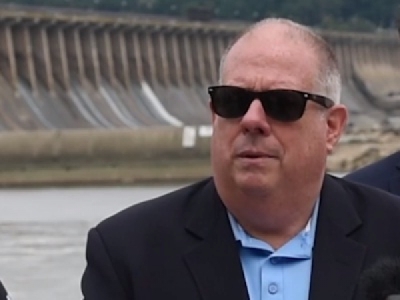
Posted on August 10, 2017
By Pamela Wood, The Baltimore Sun
Gov. Larry Hogan announced plans Tuesday for a test project to dredge some of the sediment trapped behind the Conowingo Dam, in hopes of determining whether doing so on a larger scale would be helpful to the health of the Chesapeake Bay.
Hogan said the state will ask companies this month for proposals on how to dredge the material and reuse it. The dredging would be done this winter, and then scientists would determine whether large-scale dredging is worthwhile.
Hogan could not say how much the dredging test project would cost, but the cost would be borne by the state.
Hogan has been focused on the dam, which is an active hydroelectric generating station owned by Exelon, as a source of bay pollution. The dam not only controls water flow from the Susquehanna River at the top of the bay, but it also traps sediment — the tiny bits of dirt that wash into the river from upstream rivers and creeks.
The area behind the dam has filled up with sediment and is unable to trap any more. Hogan said he worries that one big storm could wipe out recent gains that have been made in the bay’s health.
“It is absolutely vital that we find real solutions for the problem,” Hogan said at a press conference on the banks of the Susquehanna in front of the dam.
Sediment can cloud the water, preventing light from reaching underwater grasses, and it also can smother oysters and other bottom-dwelling creatures. Sediment also often has nitrogen and phosphorus bound to it, two nutrients that drive the growth of oxygen-sucking algae blooms in the water.
The Susquehanna and the Conowingo Dam are only one part of problems plaguing the health of the bay, and experts cautioned that dredging alone won’t be a cure-all for the bay’s woes.
Still, the test dredging project could provide valuable information for how to treat Susquehanna pollution as part of the bay-wide restoration strategies, said Ann Swanson, executive director of the Chesapeake Bay Commission, which advises state legislatures on bay issues.
“Innovation is always good and if we can provide a beneficial use of a pollutant, that’s good,” Swanson said.
Swanson said the bay restoration effort has not done a good job of engaging the private sector for pollution-fighting solutions, so the governor’s approach is promising.
“What’s good is they want to see what the private sector can offer in terms of innovative solutions,” Swanson said. “What we’ve tried has only gotten us halfway to the goal line.”
One year ago, the Hogan administration solicited a “request for information” asking companies to propose ideas for the Conowingo Dam sediment issue. A dozen companies responded, offering proposals such as dredging sediment and spreading it on low-quality farmland that needs nutrients, or using the dredged material to make pavers and countertops.
Maryland and surrounding states that drain into the bay should not lose sight of the variety of pollution sources in the watershed, said Bruce Michael, director of the Resource Assessment Service at the state Department of Natural Resources.
Other sources of bay pollution include farm runoff, sewage treatment plants, septic systems and storm water runoff.
“There’s no one silver bullet,” Michael said. “This is one of many strategies we need to look at.”
The test project will only dredge a tiny fraction of the sediment that’s trapped behind the dam. The request for proposals will ask companies to dredge 25,000 cubic yards, said Roy McGrath, CEO of Maryland Environmental Services, the independent agency that will oversee the project.
All told, officials estimate there’s 31 million cubic yards of sediment lodged behind the dam.
Hogan’s announcement came following his second Conowingo Dam Summit. He also toured the area in a Maryland State Police helicopter.
Source: The Baltimore Sun





